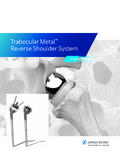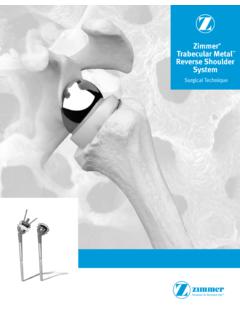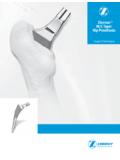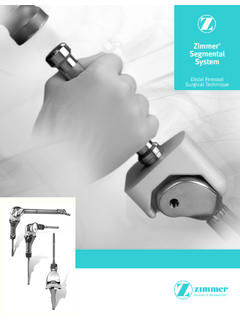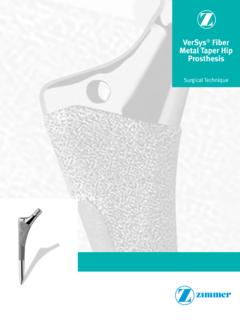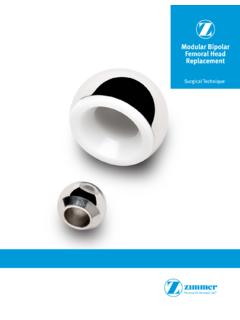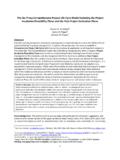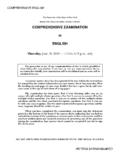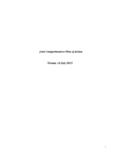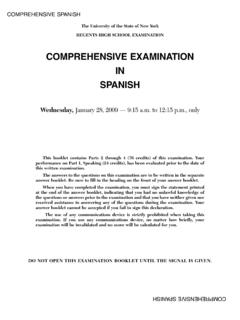Transcription of Comprehensive Reverse Shoulder System - Knee
1 Comprehensive Reverse Shoulder System Surgical TechniquePatient Positioning, Surgical Incision/Exposure ..2 Humeral Stem Technique ..4 Humeral Preparation Interamedullary Resection Guide Humeral Broachingv Calcar Planer Humeral Stem Insertion Press Fit Technique Humeral Stem Insertion Cemented TechniqueGlenoid ..14 Glenoid Preparation Baseplate Impaction Baseplate Central Screw Selection/Insertion Peripheral Screw Selection/Insertion Peripheral Screw Selection/Insertion (Optional Method) Glenosphere Selection Glenosphere Offset Glenosphere Assembly Glenosphere/Taper Adaptor Offset Direction Determination Glenosphere Orientation/ImpactionHumeral Tray and Bearing ..26 Humeral Tray and Bearing Preparation Humeral Tray and Bearing Assembly Humeral Tray/Bearing ImpactionSubscapularis Repair ..27 Revision Options ..28 Removal of Glenosphere/Baseplate Polyethylene Preparation Polyethylene RemovalCentral Post Removal.
2 29 Salvage Hemi-arthroplasty ..29 Removal of the Humeral Tray/BearingPolyethylene Humeral Bearing Removal/Exchange ..30 Fracture: Tuberosity Proximal Humerus FracturesHumeral Stem Sizing ..34 Standard Stem Mini Stem Micro Stem Comprehensive Fracture System Sizing ChartOrdering Information ..36 Table of Contents1 | Comprehensive Reverse Shoulder System Surgical TechniqueINDICATIONSB iomet Comprehensive Reverse Shoulder products are indicated for use in patients whose Shoulder joint has a grossly deficient rotator cuff with severe arthropathy and/or previously failed Shoulder joint replacement with a grossly deficient rotator cuff. The patient must be anatomically and structurally suited to receive the implants and a functional deltoid muscle is Comprehensive Reverse Shoulder is indicated for primary, fracture, or revision total Shoulder replacement for the relief of pain and significant disability due to gross rotator cuff glenospheres are intended for patients with Cobalt Alloy material sensitivity.
3 The wear of these devices has not been tested but, based on pin on disk testing, the wear rate is inferior to that of cobalt alloy glenospheres. A Cobalt Alloy glenosphere is the recommended component for Reverse Shoulder arthroplasty patients without material sensitivity to cobalt components with Hydroxyapatite (HA) coating applied over the porous coating are indicated only for uncemented biological fixation applications. The Glenoid Baseplate components are intended for cementless application with the addition of screw finish humeral stems are intended for cemented use and the MacroBond coated humeral stems are intended for press-fit or cemented applications. Humeral components with porous coated surface coating are indicated for either cemented or uncemented biological fixation contraindications include infection, sepsis, and contraindications include:1.
4 Uncooperative patient or patient with neurologic disorders who is incapable or unwilling to follow directions. 2. Osteoporosis. 3. Metabolic disorders which may impair bone formation. 4. Osteomalacia. 5. Distant foci of infections which may spread to the implant Rapid joint destruction, marked bone loss or bone resorption apparent on | Comprehensive Reverse Shoulder System Surgical TechniquePatient Positioning and IncisionSurgical PositionThe arm and Shoulder are prepped and draped free (Figure 1). Utilize a modified beach chair position at about 30 to 40 degrees of Incision/ExposureUtilize an extended deltopectoral anterior incision beginning immediately above the coracoid process and extending distally and laterally, following the deltopectoral groove along the anterior border of the deltoid (Figure 2).
5 Laterally retract the deltoid muscle, avoiding release of the deltoid from the clavicle. The deltoid may be partially released from its distal insertion by subperiosteal 1 Figure 2 This technique was prepared in conjunction with John Sperling, ; David Dines, ; Russell Warren, ; Edward Craig, ; Donald Lee, ; and Timothy Codd, Biomet does not practice medicine and does not recommend any particular orthopedic implant or surgical technique for use on a specific patient. The surgeon is responsible for determining the appropriate device(s) and technique(s) for each individual | Comprehensive Reverse Shoulder System Surgical TechniquePatient Positioning and Incision (cont.)Identify anterior structures and externally rotate the humerus. If the subscapularis is intact, make a longitudinal incision through the tendinous portion of the subscapularis muscle and capsule, just medial to the lesser tuberosity (Figure 3).
6 In cases of severe contracture, subscapularis lengthening may be the subscapularis tendon with non-absorbable sutures for easy identification during closure. Externally rotate and extend the humerus to expose the humeral head, while protecting the axillary nerve. Note: An optional biceps tenodesis may be performed to improve 34 | Comprehensive Reverse Shoulder System Surgical TechniqueFigure 4 Figure 5 Figure 6 Humeral PreparationUsing the 4, 5 or 6 mm starter reamer and ratcheting T-handle, bore a pilot hole through the humeral head along the axis of the humeral shaft, just lateral to the head s articular surface and just medial to the rotator cuff attachment. Insert the humeral reamer to the depths described below for the chosen stem.
7 Continue reaming in 1 mm increments until cortical contact is achieved. Note the reamer size for future Stem Using the standard length reamers, insert each reamer until the proximal portion of the engraved line just above the cutting teeth is even with the proximal portion of the greater tuberosity (Figure 4).Mini Stem Using the standard length reamers, insert each reamer until the large hashmark between the 3 and 4 on the reamer is even with the proximal portion of the greater tuberosity (Figure 5).Micro Stem Using the Micro length reamers, insert each reamer until the engraved line just above the cutting teeth is even with the proximal portion of the greater tuberosity (Figure 6).MiniMicroStandardStandard, Mini, and Micro Stem Technique5 | Comprehensive Reverse Shoulder System Surgical TechniqueIntramedullary Resection GuidePlace the resection guide boom onto the reamer shaft to the below described locations depending on stem selection.
8 Note: The position of the resection guide boom on the reamer shaft, along with the calibrated reaming depth and stem choice, are directly related to the proper resection height. However, the final resection height should be based off the location of the rotator cuff insertion (approximately 1 mm above the insertion). An ideal humeral resection is slightly above the rotator cuff insertion. This allows for greater glenoid Stem Place the resection guide boom on the reamer shaft and slide it up until it rests against the top of the reamer, just below the sizing engraving (Figure 7).Mini Stem Place the resection guide boom on the reamer shaft and slide it down until it rests against the base surface of the reamer, just above the cutting teeth (Figure 8).
9 Micro Stem Place the resection guide boom on the reamer shaft and slide it up until it rests against the top of the reamer, just below the sizing engraving (Figure 7) Note: The resection guide boom is NOT engraved with 7 Figure 8 Standard/MicroMini6 | Comprehensive Reverse Shoulder System Surgical TechniqueFigure 9 Intramedullary Resection Guide (cont.)Place the IM resection guide block onto the arm of the boom in the proper orientation. For example, right should be visible for a right Shoulder . Note: In chronic or fixed shoulders, a more aggressive humeral resection may be made at this point to create increased joint space for placement of the prosthesis. If there is uncertainty regarding the resection height, a standard resection should still be performed with the option to resect more bone later in the 10 Standard and Micro Technique (Figure 9).
10 Mini Technique (Figure 10).Mini7 | Comprehensive Reverse Shoulder System Surgical TechniqueIntramedullary Resection Guide (cont.)Screw the version rod into the appropriate version hole, and align the rod with the forearm flexed at 90 degrees (Figure 11). Note: The thumb screw on the resection boom is not captured. Care should be taken when adjusting/ tighteningFigure 118 | Comprehensive Reverse Shoulder System Surgical TechniqueFigure 13 Figure 12 Intramedullary Resection Guide (cont.)Set the correct version using the amount of exter nal rotation of the forearm, slide the resection guide against the humerus and finger tighten the thumb screw. Note: The thumb screw on the resection boom is not captured. Care should be taken when adjusting/ two threaded Steinman pins through converging angled holes in the resection guide block and into the bone to secure the block to the bone.
